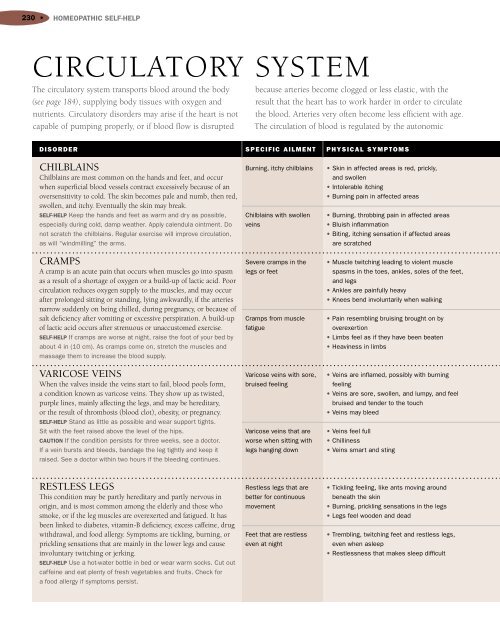Encyclopedia of Homeopathy
Encyclopedia of Homeopathy
Encyclopedia of Homeopathy
Create successful ePaper yourself
Turn your PDF publications into a flip-book with our unique Google optimized e-Paper software.
230 •HOMEOPATHIC SELF-HELPCIRCULATORY SYSTEMThe circulatory system transports blood around the body(see page 184), supplying body tissues with oxygen andnutrients. Circulatory disorders may arise if the heart is notcapable <strong>of</strong> pumping properly, or if blood flow is disruptedbecause arteries become clogged or less elastic, with theresult that the heart has to work harder in order to circulatethe blood. Arteries very <strong>of</strong>ten become less efficient with age.The circulation <strong>of</strong> blood is regulated by the autonomicDISORDERCHILBLAINSChilblains are most common on the hands and feet, and occurwhen superficial blood vessels contract excessively because <strong>of</strong> anoversensitivity to cold. The skin becomes pale and numb, then red,swollen, and itchy. Eventually the skin may break.SELF-HELP Keep the hands and feet as warm and dry as possible,especially during cold, damp weather. Apply calendula ointment. Donot scratch the chilblains. Regular exercise will improve circulation,as will “windmilling” the arms.CRAMPSA cramp is an acute pain that occurs when muscles go into spasmas a result <strong>of</strong> a shortage <strong>of</strong> oxygen or a build-up <strong>of</strong> lactic acid. Poorcirculation reduces oxygen supply to the muscles, and may occurafter prolonged sitting or standing, lying awkwardly, if the arteriesnarrow suddenly on being chilled, during pregnancy, or because <strong>of</strong>salt deficiency after vomiting or excessive perspiration. A build-up<strong>of</strong> lactic acid occurs after strenuous or unaccustomed exercise.SELF-HELP If cramps are worse at night, raise the foot <strong>of</strong> your bed byabout 4 in (10 cm). As cramps come on, stretch the muscles andmassage them to increase the blood supply.VARICOSE VEINSWhen the valves inside the veins start to fail, blood pools form,a condition known as varicose veins. They show up as twisted,purple lines, mainly affecting the legs, and may be hereditary,or the result <strong>of</strong> thrombosis (blood clot), obesity, or pregnancy.SELF-HELP Stand as little as possible and wear support tights.Sit with the feet raised above the level <strong>of</strong> the hips.CAUTION If the condition persists for three weeks, see a doctor.If a vein bursts and bleeds, bandage the leg tightly and keep itraised. See a doctor within two hours if the bleeding continues.SPECIFIC AILMENTBurning, itchy chilblainsChilblains with swollenveinsSevere cramps in thelegs or feetCramps from musclefatigueVaricose veins with sore,bruised feelingVaricose veins that areworse when sitting withlegs hanging downPHYSICAL SYMPTOMS• Skin in affected areas is red, prickly,and swollen• Intolerable itching• Burning pain in affected areas• Burning, throbbing pain in affected areas• Bluish inflammation• Biting, itching sensation if affected areasare scratched• Muscle twitching leading to violent musclespasms in the toes, ankles, soles <strong>of</strong> the feet,and legs• Ankles are painfully heavy• Knees bend involuntarily when walking• Pain resembling bruising brought on byoverexertion• Limbs feel as if they have been beaten• Heaviness in limbs• Veins are inflamed, possibly with burningfeeling• Veins are sore, swollen, and lumpy, and feelbruised and tender to the touch• Veins may bleed• Veins feel full• Chilliness• Veins smart and stingRESTLESS LEGSThis condition may be partly hereditary and partly nervous inorigin, and is most common among the elderly and those whosmoke, or if the leg muscles are overexerted and fatigued. It hasbeen linked to diabetes, vitamin-B deficiency, excess caffeine, drugwithdrawal, and food allergy. Symptoms are tickling, burning, orprickling sensations that are mainly in the lower legs and causeinvoluntary twitching or jerking.SELF-HELP Use a hot-water bottle in bed or wear warm socks. Cut outcaffeine and eat plenty <strong>of</strong> fresh vegetables and fruits. Check fora food allergy if symptoms persist.Restless legs that arebetter for continuousmovementFeet that are restlesseven at night• Tickling feeling, like ants moving aroundbeneath the skin• Burning, prickling sensations in the legs• Legs feel wooden and dead• Trembling, twitching feet and restless legs,even when asleep• Restlessness that makes sleep difficult
















